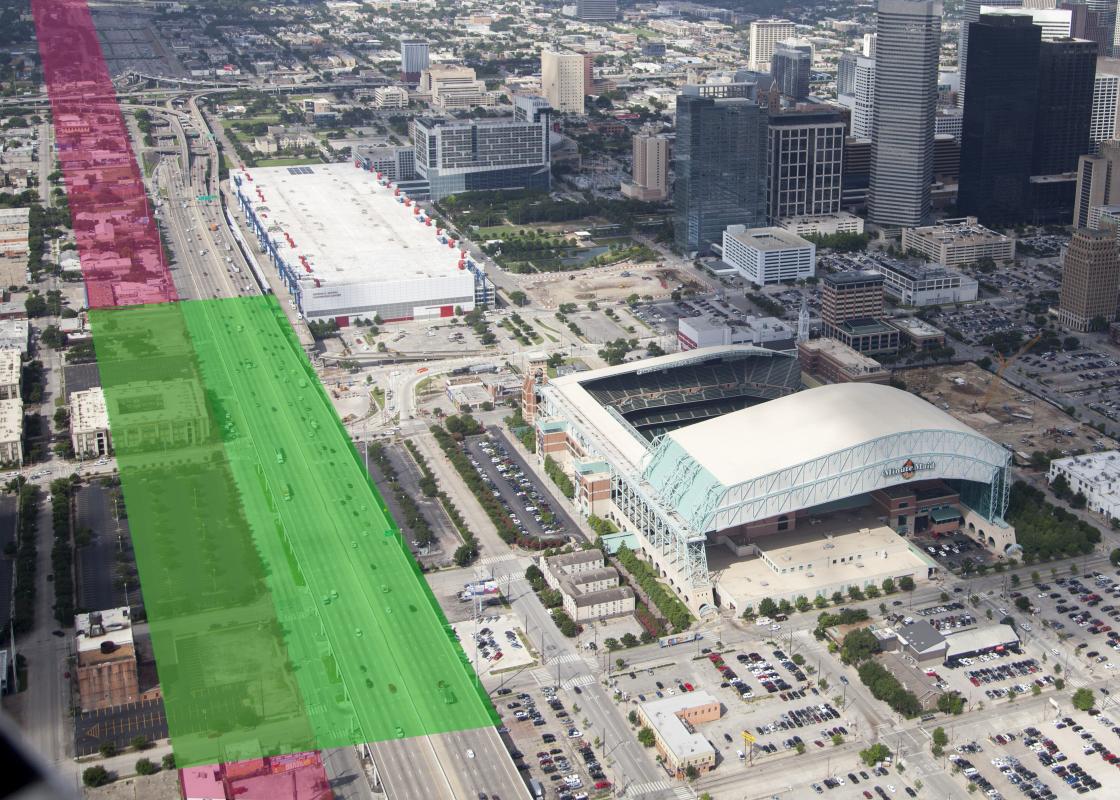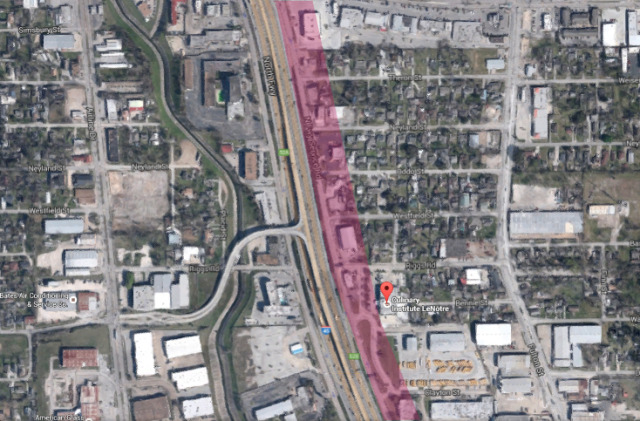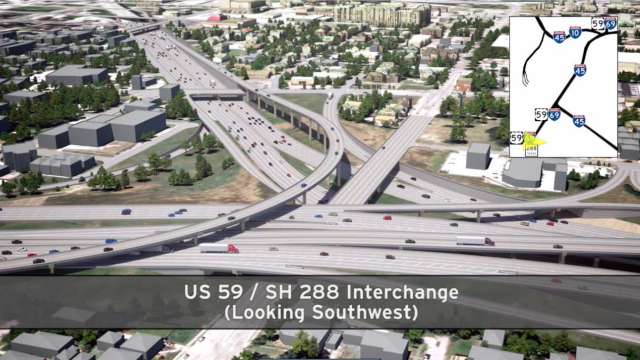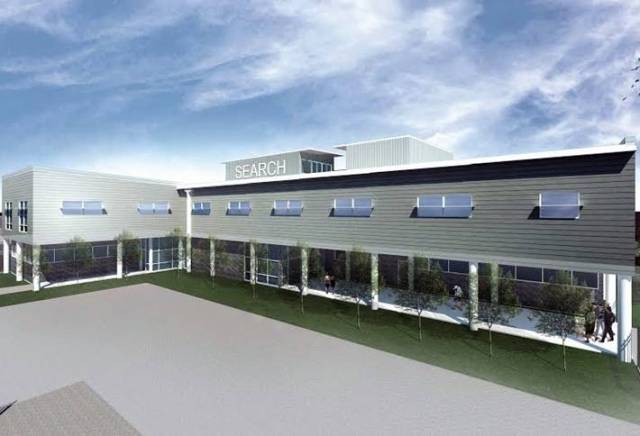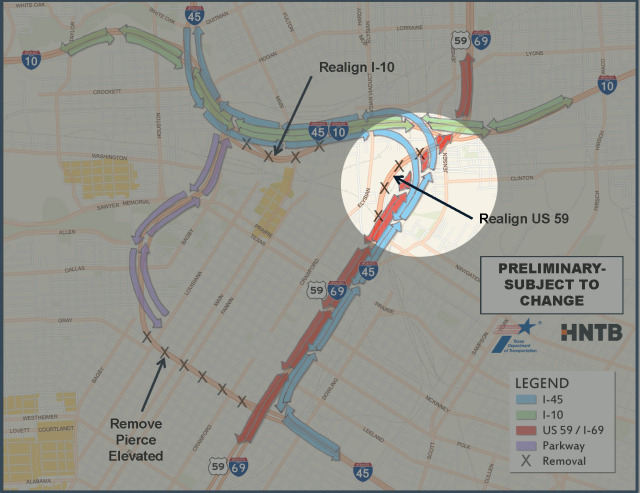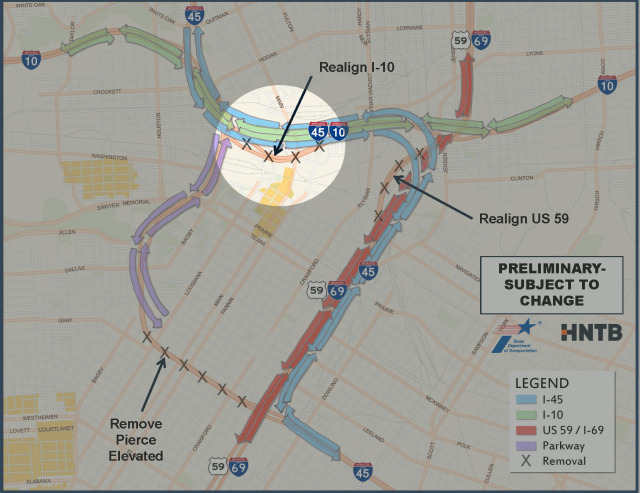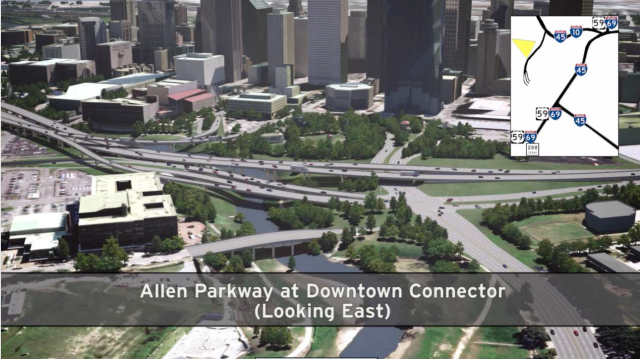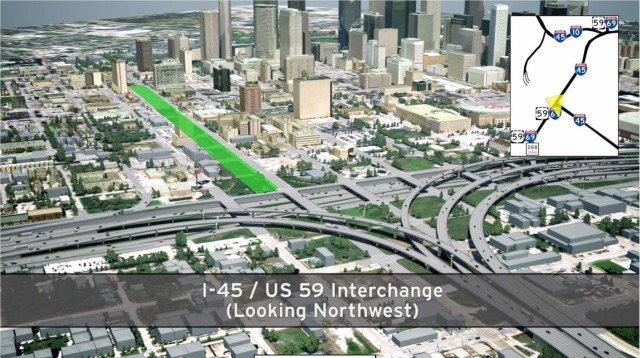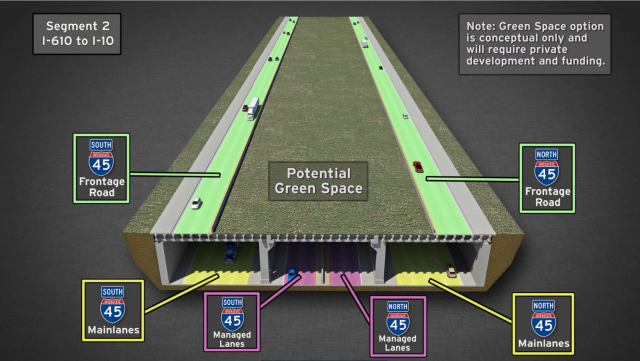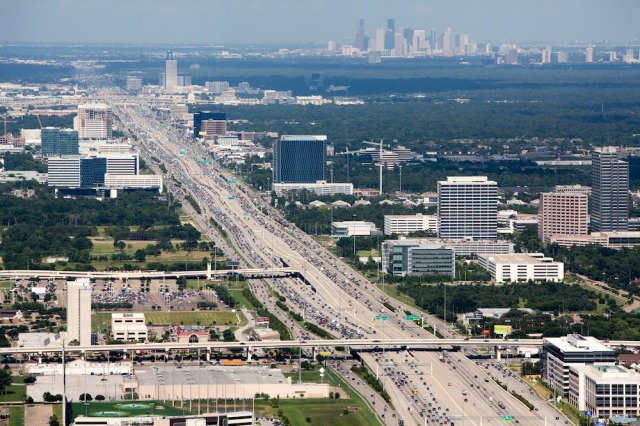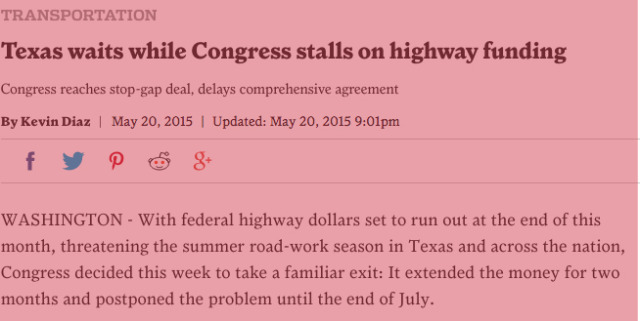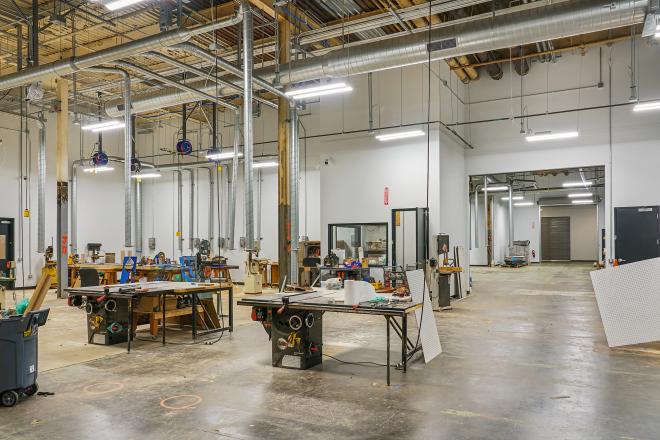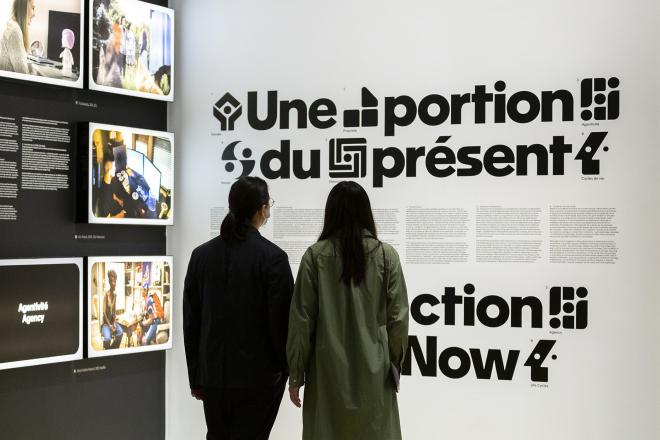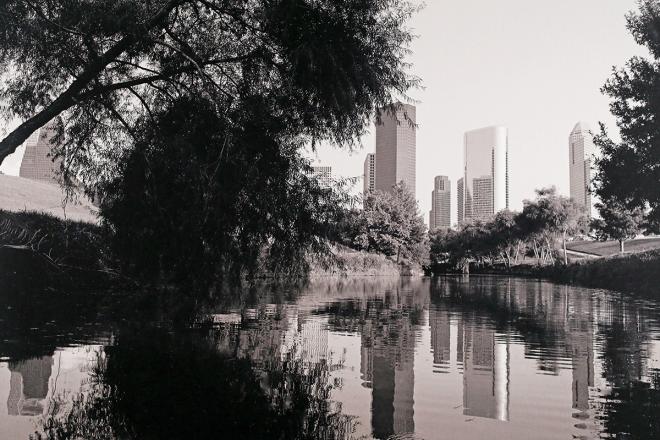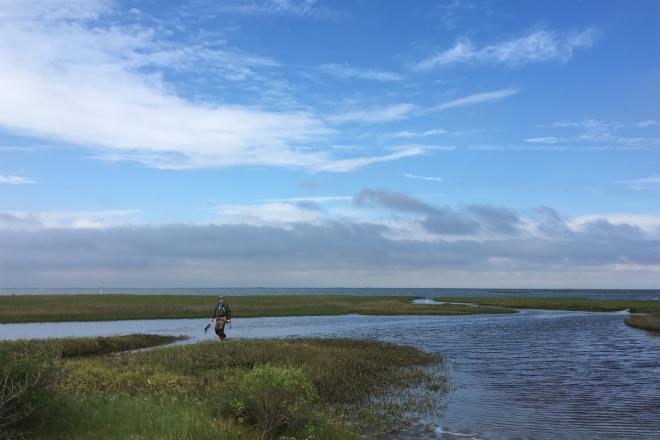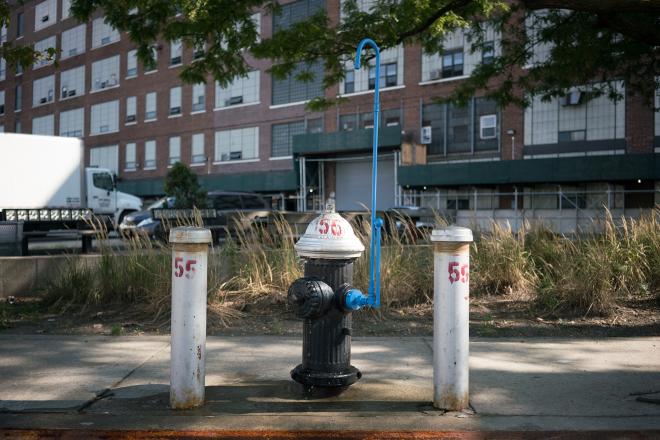Also known as I45NorthAndMore.com, the North Houston Highway Improvement Project has made headlines not only because of the potential removal of the Pierce Elevated, but also of the possibility of turning it instead into a Sky Park.
There’s nothing quite so fetching in urban design these days as a Sky Park, but if you look beyond that glittery, and unlikely, dangling object, there’s a whole lot more to the proposal. Namely:
1. I-45 Would Rival I-10 in Width
The plan would dramatically widen I-45 to more than 30 lanes in certain sections. North of 610, I-45 would rival the Katy Freeway in its expanse. Though the west side of I-45 at Crosstimbers is largely vacant, TxDOT plans to take major right of way east of I-45 where many businesses thrive, including the Culinary Institute. The greater capacity to move automobiles might be accompanied by increased cancer risk and asthma for Houstonians generally, and for those living close to the path in particular.
2. I-69 Would Be Sunken through Midtown and Museum District
All of I-69 from Shepherd to Commerce Street would be sunk as deep as 20 feet below grade. That is to say, all the above-ground sections in Midtown and the Museum District (Greater Third Ward) would be sunken and widened, radically transforming the landscape in these neighborhoods. As Tory Gattis notes, the plans would eliminate the bottleneck at Spur 527.
3. TxDOT Would Demolish Apartments, Public Housing, and Homeless Services in EaDo
Lofts at the Ballpark, Clayton Homes (public housing), and the SEARCH building (a 27,000-square-foot facility for services to the homeless that is just now breaking ground) are in the path of the widened I-45/I-69 freeway east of Downtown, and will be torn down at the expense of taxpayers.
4. James Bute Park Might Have a New Life
Straightening I-69 might yield a Bute Park that is less isolated from surrounding Downtown sites. TxDOT could use the site for required flood control, which would open a range of opportunities to layer uses such as recreation and wildlife habitat. A controversial plan to use the site for public housing was recently nixed.
5. University of Houston-Downtown Campus Reconnected
With I-10 moved to the freight rail line north of campus, the University of Houston-Downtown (UHD) would see dramatic change. Currently, I-10 bifurcates the campus. Presumably, the land swap will benefit UHD by creating a unified campus.
6. New Slimmed-Down Bridges for Cars to Cross Buffalo Bayou
The section of the "Pierce Elevated" over Buffalo Bayou would be rebuilt with new Downtown connectors that TxDOT alternately describes as "parkways" and "spurs." Though the official rendering is dull, the public-private partnerships that have rebuilt the parks along the bayous might help bring about new iconic bridges for cars. A Sky Park in this location is unlikely because moving traffic across the bayou is considered a major priority for many stakeholders.
7. Decommisioning of Pierce Elevated Would Come Last
The decommissioning of the Pierce Street section of the "Pierce Elevated" will be the last piece in the entire puzzle. The rerouting and rebuilding of I-45 along I-10 and I-69 has to take place first. It is unlikely that the demolition or creation of Sky Park would take place until well after 2020. The Houston Chronicle has published pieces favorable to and discouraging of proposals for a Sky Park. The Kinder Institute published a wonderful history of the highway by Kyle Shelton with vintage drawings. Eric Jaffe of CityLab weighed in as well.
8. Funding for the Project Is in Question
This project is unfunded. Every year, Texas has $1 billion in funding for highways. This project alone would cost in the range of $6 billion and would take years to be completed in a piecemeal fashion. The record of decision might happen next year. Then acquisition of land could begin. It would be shovel ready in 2019 at the soonest. Additionally, consider that the entire highway system is underfunded.
9. Bridges North of Downtown Rebuilt with Possible Park Capping Sunken Freeway
Bridges inside 610 to Downtown would be torn down including North Main, Cottage, and North streets. TxDOT could rebuild them with protected paths for pedestrians and cyclists, pedestrian-friendly lighting, and designs similar to the “red ball” bridges over 59.
10. Impact on Traffic Congestion is Unknown and Might Mirror That of I-10 Widening
The I-45 project includes regular lanes and two managed lanes in each direction north of Downtown. If the impact of this project mirrors that of I-10, the addition of regular lanes will not reduce congestion and travel times. Increased capacity generally encourages or accommodates more car-dependent development and more cars on the road --- a phenomenon known as induced demand. The managed lanes would be kept free of traffic congestion for commuter buses and high-occupancy vehicles through tolls for single-occupant vehicles. The tolls for I-10 were recently raised to $10, among the highest in the nation. In addition, autonomous cars and buses are expected to be on the road by the time this project is completed. The design does not take the impact of those emerging technologies into consideration.
The period for public comment has been extended to May 31, and the Architecture Center Houston is holding a public meeting on the project June 10.


